

Three stories to both inspire you and provide useable advice in your quest to deliver the best customer service possible.
We’re huge advocates for building a business based on customer satisfaction, which is why we always love dealing with companies who adopt this mentality. We use Buffer, Slack and Pivotal Tracker every day, and love the way they do business.
We use Buffer for its social media scheduling awesomeness, Slack for all our internal communications (handy with our international team) and Pivotal Tracker for all our task management.
Everyday use means from time to time we get in touch with each app’s support team - to let them know how awesome they are, share our ideas for future development or ask for their ideas to solve a problem.
We’ve worked with and experienced customer service of dozens of software companies - and these three stand out from the crowd by a long way - a big reason why they’ve accumulated so many customers in a short space of time.
Matched with our own values, they know that growing a business through customer satisfaction is very rewarding and also makes perfect sense. You win customers one at a time.
Learn by their example and you’ll likely see an upturn in customer retention, word of mouth referrals and increased sales as a result - just like Buffer, Slack and Pivotal.
Buffer set out their stall right from the get-go. As soon as you sign up for their free trial, an email is shot off to welcome you aboard.
For an autoresponder it’s an amazingly inviting email to receive. It’s written in a very conversational style, in Joel’s voice - with just the right amount of info and direction included.
The main purpose of this email is to open up all kinds of methods of communication directly with the new trialist - emphasising their support email address and twitter handle, as well as direct communication with Joel himself.
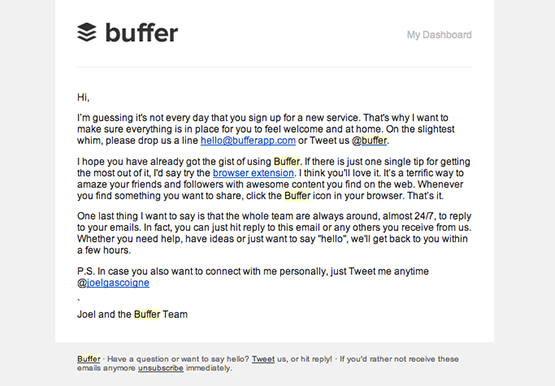
They draw attention to their dedication to customer service with their almost 24/7 ability to respond and deal with anything from complaints, to suggestions, to just saying hi.
This reassures trialists, and immediately differentiates Buffer from other social media platforms you might be comparing their app to.
Their auto-responder email series, as well as any feature/company announcements are always written from Joel, in his voice. He is the constant visible figure within the company.
However - their dedication doesn’t end there. Their happiness experts are stationed around the world to respond asap to any incoming email to their support. And boy oh boy do they do a great job.
Doug, our social media go-to guy, primarily deals with our Buffer account and is a huge advocate for their customer-centric approach.
Recently he decided to get in touch with Buffer’s team to suggest an improvement that had popped into his mind.
His idea is for Buffer to notify users whenever they are mentioned online, to help you schedule replies and thank-you’s.
He was AMAZED by their response, which appeared in his inbox about 30 minutes later.
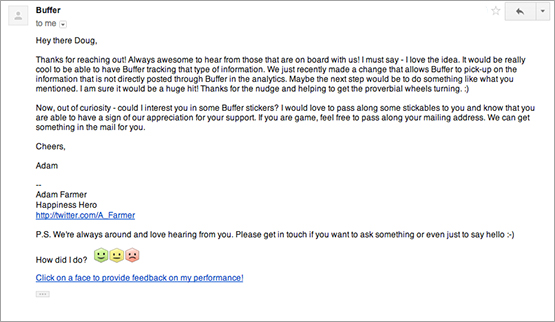
It’s a fully customised email that thanks Doug for reaching out, lets him know his suggestion is cool and offers to send him some Buffer stickers as a little show of gratitude.
By taking the time to fully answer Doug’s enquiry - Adam has ensured our love for Buffer has grown and made us even bigger ambassadors as a result.
Pivotal Tracker recently refreshed their app - and overall, the new design is clean, fresh and modern.
Though I’m very pleased with most of the changes they’ve made, there was one particular aspect that immediately felt weird to me.
They had implemented fixed widths for each column in the UI. The old design resized your columns automatically for you, but the new one didn’t.
I found myself constantly needing to move things around and fiddle with settings to get things how I wanted it to be.
It seemed that every two minutes I’d end up with a window with wasted space, or even worse a horizontal scroll bar as the panes bled outside the window space.
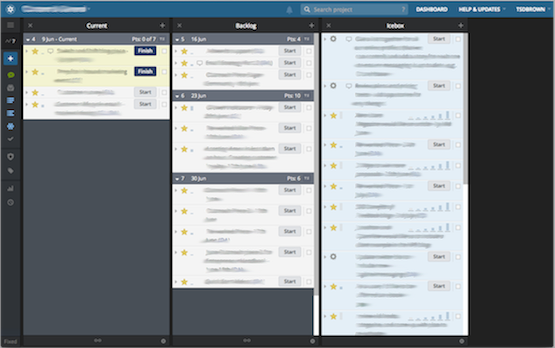
PT has a built in “feedback” mechanism, so I sent them my thoughts. It turns out we weren’t the only one suffering.
Not only did Chris send a reply the very same day, but he also took the time to understand my problem and offered more helpful advice, even explaining why they made the change in the first place.
Hi Luke,
Thanks for your feedback.
We are bringing back auto-resizing panels as an option. The reason we changed it was because people had requested fixed width panels for optimal line-lengths they could control, as well as the fact that people were losing track of where their stories were when panels were closed because stories would move up/down as panels got wider/narrower. We will support both as options in the near future.
Hope this helps,
Chris
I was so pleased to see their dedication to being honest, responsive, and receptive to customer needs. Within days this appeared in the “Recent Updates” feed:
Auto panel resizing option
You asked, we agreed, and you can now click “Fixed” at the bottom left of the side bar to toggle panel resizing to “Auto”. This disables the manual options, but just click Auto again to get those back. Mouse over each control for a tooltip to tell you what it does.

This means the window now always stays like this:
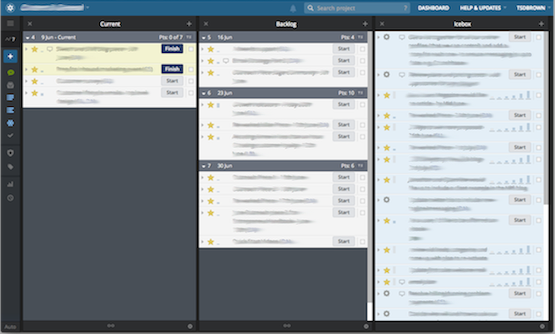
Making changes is always tricky, people often don’t like it. If you listen to customers, treat them as individuals and implement changes that the bulk of people request, you’ll earn the trust and respect of customers, keeping them as advocates.
If you ignore them on the other hand, by not responding or asking for their thoughts and following up - you might find people start quietly voting with their feet.
Slack is our constant companion - it’s hard to imagine working as a team without Slack! As we’ve grown to an internationally based team, communication between us is even more important.
In essence, Slack is an instant messaging tool which can be integrated with numerous other applications to help generate knowledge sharing as we each get on with our different tasks.
Guy recently got in touch with Slack, as we do from time to time, to ask them about the possibility of reducing the side navigation panel’s size to help free up space in the rest of the browser screen.
Carrie got back to Guy within 10 minutes!
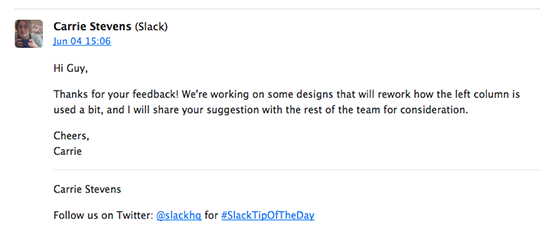
Carrie communicated everything Guy needed to know - and did it so quickly that we’re very, very impressed with their dedication.
Replying to customer queries doesn’t need to be complicated or long-winded. All it needs to be is prompt, relevant and polite.
It’s for the reasons outlined above that Buffer, Slack and Pivotal are very likely to keep our business for a long time to come.
Leslie Harvey is the customer service manager at the American Association of Clinical Chemistry - it’s her belief that:
“If you do what’s right, all the charts go in the right direction.”
After considerable research, Leslie decided our service was the best fit for her and her team. However, when it came to subscribing after the free trial, she hit a stumbling block.
We didn’t support American Express.
Not thinking twice, Guy was on the phone to AmEx discussing our options and before the evening was out, we had the basic integration done, and we were able to accept Leslie’s card the very next day.
She was blown away by this. We were delighted to win her as a new customer, and in fact had won a new advocate too.
Every customer has different needs and questions to be answered - here are 5 ways to ensure you can delight every customer like Buffer, Slack and Pivotal do.
Guy built a customer first culture into our business from day one. Everyone we hire, or work with must deeply care about doing the right thing.
Prospects, advocate customers, and the few people that have left us over the years are all cared for to best of our ability - wherever they are in the customer lifecycle, we make sure they are treated in the same way.
Your team will find it liberating that anything goes when it comes helping people. I know if my goal is to delight someone who touches our company, whatever I do will be applauded - even if it fails.
The culture should make it clear that everyone can and should put the customer first - allowing them to do what it takes to delight customers.
When it comes from the top down, it’s easy to follow.
You need to respond to every customer’s needs in a consistent way.
Leslie had other questions apart from the payment system, and different members of our team helped Leslie at different times. Those interactions added up to her overall experience.
The experience with your company can soon degrade if one person is kind and helpful but the next is not.
If you can’t meet a customer’s needs, be honest about why, often they’ll appreciate the facts and they’ll work around them.
Be willing to recommend another approach or even a competitor if that will fit their needs or help them more than you can.
A hoodwinked customer is going to be “at risk” from the get-go.
We’re only human. It’s almost unavoidable that on the odd occasion a call gets missed or an email gets forgotten - you must aim to minimise that, but it’s going to happen.
A heartfelt apology with a truthful explanation goes a long way to buying back trust.
Every time you do something for a customer, follow-up and double check it helped. Never assume it was right - know it was.
They’ll appreciate that you care and that you’re treating them personally. People see your great service and you’ll stand out.
Leslie sums up this point brilliantly:
“You can’t know how well you’re doing with customer service unless you ask the customers. And you can’t fix any problems unless you know what they are.”
We hope that these examples can help you to implement fantastic customer service within your business. If you need some actionable advice about using Voice of the Customer to improve customer experience, just ask us for a free assessment. We’ll listen to your current challenges, and suggest some next steps.
Find out more about the deep partnerships we have with our clients here.
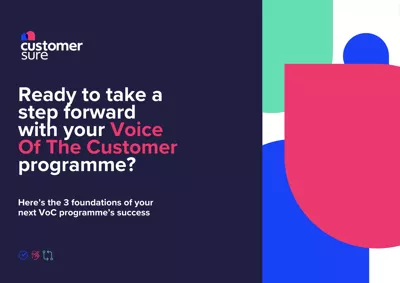
Ready to elevate your VoC programme and ensure success using our expert guide? Learn the three foundations required for success.
Discover more »Connect with a CX expert who’ll help determine your current VoC programme maturity level and provide a 3-step action plan to improve.